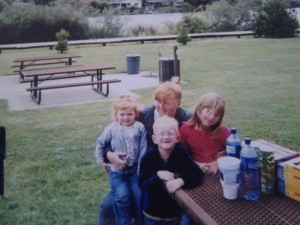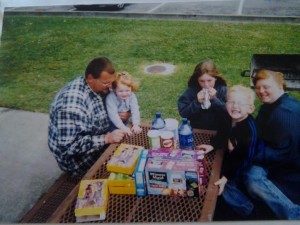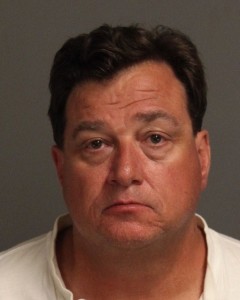Dollars or sense for Carroll family children?
August 3, 2015

Elizabeth Carroll with her children in 2001.
By KAREN VELIE and DANIEL BLACKBURN
Editor’s Note: This is the last of a three-part exclusive series detailing how three children were taken from their parents and placed in a home with a man now accused of sexual assault. Find part one here and part two here.
San Luis Obispo County expects $21 million in revenue from the state and federal government for its foster parenting and adoption programs for the 2015-2016 budget year. That provides agencies such as the county, affiliated non-profits such as Community Action Partnership of San Luis Obispo (CAPSLO), psychologists, attorneys and the courts with a financial stake in taking children from their birth parents.
The Adoption and Safe Family Act, passed in 1997, provides bonuses of $2,000 to $6,000 to state and county governments for moving foster children into adopted families. Additionally, the county receives monthly subsidies for adopted families of up to $1,450 per child. The county keeps a 40 percent administration fee from the foster and adopted children’s subsidies before sending the remainder to be used for the child’s needs, according to a report by the California State Auditor.
The cost to the county for foster children deemed un-adoptable can top the 40 percent administration fee, as many of these children require costly ongoing county oversight and multiple services.
But, adoptive children provide a county funding source that allows the county to forego the costly oversight required for foster children. A child qualified for adoption subsidies can bring in revenue of up to $300,000 to be split between the county and adopted parents if the child is taken from its birth parents as an infant, according to California’s current adoption subsidy funding schedule.
CalCoastNews has been reporting in this series on three children who were taken from their birth parents and adopted by a couple in Nipomo. The husband and adoptive father, Robert John Bergner, 51, has been charged with 126 counts of child abuse, rape and sodomy of the eldest child.

The Carroll family before the court terminated Richard and Elizabeth Carroll’s parental rights.
Questions have been raised about the process that appears to have led Superior Court Commissioner Sidney B. Findley to terminate the parental rights of Richard and Elizabeth Carroll and permit the adoption of the children by Bergner and his wife.
The Carrolls were homeless and the Bergners had their own home.
“I am convinced these children need permanency and that is what the law requires,” Findley said in his ruling. “All decisions that I make, I make because I believe they are in the best interest of the children.”
But a review of the process suggests that Findley may not have been given a complete or accurate picture of the birth parents.
Shortly after taking their three children into custody, social workers ordered Richard and Elizabeth Carroll to have a psychological exam with Jeffrey J. Lille, Ph.D. According to Lille’s report, the county provided him with information first generated from former Prado Day Center Manager Dee Torres. Torres claimed that Elizabeth Carroll punched her 5-year-old daughter.
San Luis Obispo Police Officer Mike Brennler responded to the call and, based on his own questioning of the child and his direct observation, determined that Elizabeth Carroll had not punched the girl and had not abused her younger brother. That information was not in Lille’s report.
The Carrolls met with Lille on Dec. 31, 2001 for a little less than an hour, they said. Lille discussed their childhoods and gave them several tests, according to court records.

Foster and then adoptive parent Robert Bergner was arrested last month for rape and sodomy.
Lille’s report says he ran four tests – the MMPI-2, the Rorschach Psychodiagnostic test, the Thematic Apperception Test, and sections of the Wechsler Adult Intelligence Scale – on each parent.
The Wechsler Adult Intelligence Scale assessment takes from 42 minutes to an hour, clinical trials have demonstrated.
The Thematic Apperception Test involves showing the test subject 31 picture cards and having the subject tell a story about each picture.
The Rorschach Psychodiagnostic test requires a test subject to look at 10 images/inkblots. The subject tells the medical professional what the subject sees. The test then requires the subject to look at the images again and explain how the subject saw what was reported.
The MMPI-2 test alone takes between 60 minutes and 90 minutes to administer causing several mental health professionals to question Lille’s report in light of the Carrolls’ memory of a visit that ran less than an hour.
In Lille’s 17-page report, he says Richard Carroll has socialization deficits stemming from his childhood and a low to average IQ, and is likely to have future legal issues. In the almost 14 years since Lille saw Richard Carroll, he has not been arrested or had other legal issues. Richard Carroll has been employed as a security officer, a job requiring a clean police record, since 2008.
Lille states Elizabeth Carroll should attend parenting classes and only have supervised visits with her children.
Lille lists himself as a licensed psychologist. It does not mention that he was on probation at the time he met with the Carrolls, and required to inform all current and potential parties in a signed release about his probation and its effects on his patients’ and employer’s confidentiality.
On Nov. 2, 1999, the state revoked Lille’s license following an investigation into charges he received oral sex from a patient during a session; that he had sex with several patients after sessions; that he smoked marijuana with patients; and that he performed exorcisms, according to court records.
“While serving as Crystal B.’s treating psychotherapist, respondent told Crystal B. he observed a three-headed monster above Crystal B.’s head during a hypnotherapy session,” according to a Dec. 14, 1998 accusation by the Attorney General of the State of California. “Respondent told Crystal B. the monster indicated that she was possessed. Respondent then worked for over a year to exorcise the demons.”
In the process that led to have the revocation stayed and five-years probation, Lille admitted to inventing the “monster” and smoking marijuana with patients.
On Jan. 21, 2000, Lille received five-years probation which included a six-month license suspension, oversight of his practice, and a requirement to have all clients sign a release stating that they were aware of issues related to Lille’s probation, according to a stipulated settlement and disciplinary order.
In Lille’s report that the county’s Department of Social Services provided to the court, it does not mention his probation.
Throughout California, multiple lawsuits have been won against counties for returning seriously abused children often deemed un-adoptable to abusive homes. At the same time, birth parents have won suits against counties and social workers who fabricated or withheld evidence in order to permanently remove adoptable children from their birth parents.
County social workers often describe in reports that children are dirty, have lice, and are acting strangely, while probing parents’ histories. Any past history of mental illness or drug or alcohol treatment can result in actions to terminate parents’ rights, county records show.
In the case of the Carroll family, even though there was no report of any physical abuse by Richard Carroll, witnessed or documented injuries consistent with abuse, county social workers told the court the father was extremely abusive to his eldest daughter, court records show.
In addition, the Carrolls have no adult history of non-traffic-related legal issues, though Richard Carroll admitted that several years before his eldest daughter was born, he had used drugs. Court documents subsequently revealed that county staffers (and others representing entities receiving monies from social services) noted repeatedly that the father’s participation in Narcotics Anonymous and admission of prior use were concerning — even though the Carrolls had not tested positive for drug use,
In 1998, The National Center on Child Abuse and Neglect reported that six times as many children died in foster care than in the general public and that once removed to official “safety,” these children are far more likely to suffer abuse, including sexual molestation, than children raised by their birth families.
In 2003, the California Little Hoover Commission reported that 30 percent to 70 percent of the children in California group homes did not belong there, and should not have been removed from their homes.
Allegations and actions of child welfare services workers and the juvenile court are shrouded in secrecy to protect children. However, the lack of transparency also protects the actions of those who benefit financially from having little or no oversight, critics say.
In the case of the Carrolls, unfounded claims that a child was “punched” and of physical abuse by the father were reported by a non-profit agency that receives county funding. The assertions were then repeated by county staffers to a psychologist paid by the county.
The psychologist repeated the initial claims by Torres at the non-profit in his reports, which county social workers memorialized in their statements to the court
On Aug. 18, 2003, Christopher Monza, a San Luis Obispo County social worker, noted psychologist Lille’s report eight times in his testimony to the court, though he never mentioned the doctor was on probation for allegedly having sex with his patients, or that he invented monsters in order to keep a patient returning to him for an ongoing exorcism.
“I’m relying on Dr. Lille’s report as well and what he found,” Monza testified to the court, according to the court transcript. “Dr. Lille, even though he finds that there are, there is bonding between the children and the parents, he makes a conclusion at the idea that the birth parents’ relationship promotes the well-being of the children, but does not exist to such an extent that it would outweigh the permanent home of the adoptive parents.”
Shortly after listening to Monza’s testimony, Superior Court Commissioner Sidney B. Findley terminated the parental rights of the Carrolls paving the way for the adoptions.
Get links to breaking news, like CCN on Facebook.






The comments below represent the opinion of the writer and do not represent the views or policies of CalCoastNews.com. Please address the Policies, events and arguments, not the person. Constructive debate is good; mockery, taunting, and name calling is not. Comment Guidelines